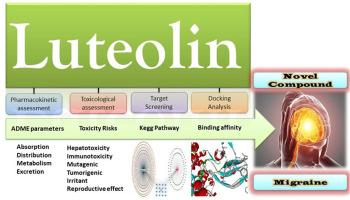Unlocking the potential of luteolin: A natural migraine management approach through network pharmacology
IF 3
3区 医学
Q1 INTEGRATIVE & COMPLEMENTARY MEDICINE
Journal of Traditional and Complementary Medicine
Pub Date : 2024-05-01
DOI:10.1016/j.jtcme.2024.04.011
引用次数: 0
Abstract
Background
Luteolin, a natural flavonoid, exhibits antioxidant and anti-inflammatory properties and has been investigated for potential health benefits. Its focus on migraine management arises from its ability to mitigate neuroinflammation, a key factor in migraine attacks.
Methods
pkCSM and Swiss ADME were employed to assess luteolin's pharmacokinetic properties, revealing challenges such as low water solubility and limited skin permeability. OSIRIS Property Explorer is used to check the toxicity. Ligand binding simulations indicated luteolin's potential to interact with calcitonin gene related peptide proteins, crucial in migraine pathophysiology. DisGeNet identified common targets related to migraine, with subsequent network analysis emphasizing promising targets.
Results and Discussion
Luteolin demonstrated good intestinal absorption but faced BBB limitations, suggesting a potential for oral administration but questioning direct brain impact. Nanoformulation was proposed to address solubility challenges, emphasizing the need for in vivo validation. The highest binding affinity with CGRP proteins PDBID: 6PFO (−7.63 kcal/mol) suggested a potential for migraine treatment, requiring empirical confirmation. Enrichment network analysis illustrated luteolin's potential in migraine treatment, emphasizing key targets such as PTGS2, AKT1, ESR1, MMP2, and MMP9. Luteolin shows promise for migraine management, evident in its pharmacokinetic, toxicological profiles, and interactions with CGRP proteins. Challenges like low solubility suggest the need for nanoformulations and empirical validation. Target identification and network analysis offer insights, highlighting potential therapeutic avenues in migraine treatment.
Conclusion
Luteolin holds promise in migraine management, necessitating further research for translation into effective interventions, considering its neuroprotective potential in broader neurological conditions.

释放木犀草素的潜能:通过网络药理学管理偏头痛的天然方法
背景木犀草素是一种天然类黄酮,具有抗氧化和抗炎特性,已被研究用于潜在的健康益处。偏头痛发作的一个关键因素是神经炎症,而叶黄素能够减轻神经炎症,因此成为偏头痛治疗的重点。方法采用了SpkCSM和Swiss ADME来评估叶黄素的药代动力学特性,发现了其面临的挑战,如水溶性低和皮肤渗透性有限。OSIRIS Property Explorer 用于检查毒性。配体结合模拟表明,木犀草素有可能与降钙素基因相关肽蛋白发生相互作用,而降钙素基因相关肽蛋白在偏头痛的病理生理学中至关重要。DisGeNet 确定了与偏头痛有关的常见靶点,随后的网络分析强调了有希望的靶点。为解决溶解性难题,研究人员提出了纳米制剂,强调了体内验证的必要性。与 CGRP 蛋白的最高结合亲和力 PDBID: 6PFO (-7.63 kcal/mol)表明其具有治疗偏头痛的潜力,但需要经验证实。富集网络分析显示了木犀草素治疗偏头痛的潜力,强调了 PTGS2、AKT1、ESR1、MMP2 和 MMP9 等关键靶点。叶黄素的药代动力学、毒理学特征以及与 CGRP 蛋白的相互作用表明,叶黄素有望用于偏头痛的治疗。低溶解度等挑战表明需要纳米制剂和经验验证。结论叶黄素有望用于偏头痛的治疗,考虑到它在更广泛的神经系统疾病中的神经保护潜力,有必要开展进一步的研究,以便将其转化为有效的干预措施。
本文章由计算机程序翻译,如有差异,请以英文原文为准。
求助全文
约1分钟内获得全文
求助全文
来源期刊

Journal of Traditional and Complementary Medicine
Medicine-Complementary and Alternative Medicine
CiteScore
9.30
自引率
6.70%
发文量
78
审稿时长
66 days
期刊介绍:
eJTCM is committed to publish research providing the biological and clinical grounds for using Traditional and Complementary Medical treatments as well as studies that demonstrate the pathophysiological and molecular/biochemical bases supporting the effectiveness of such treatments. Review articles are by invitation only.
eJTCM is receiving an increasing amount of submission, and we need to adopt more stringent criteria to select the articles that can be considered for peer review. Note that eJTCM is striving to increase the quality and medical relevance of the publications.
 求助内容:
求助内容: 应助结果提醒方式:
应助结果提醒方式:


